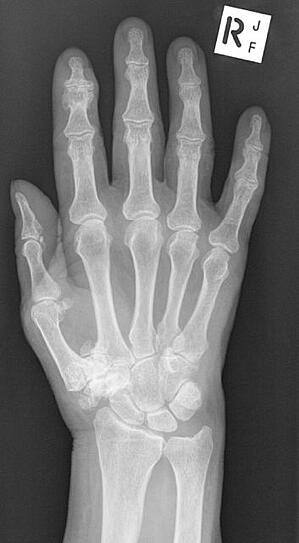The Painful Thumb: Arthritis at the base

By Ray Jongs, Hand Physiotherapist
There are many causes of pain at the base of the thumb.
But commonly, the thumb starts to become painful because of wear and tear of some of the small joints - osteoarthritis.
Our thumbs are fascinating and unique because we can place our thumbs in such a way as to hold and manipulate things easily. Our thumbs move into this position of 'opposition' to other fingers through rotation at the base of the thumb, between a very small bone (the trapezium), and the longer bone (the metacarpal).
Unfortunately, wear and tear of the base of the thumb may involve more than this joint of opposition, and possibly involve a more extensive process that includes the wrist (mid carpal joint).
X-rays of the base of thumb can tell which joints are involved. However, the degenerative changes seen may not correlate to pain or loss of function; some people have terrible looking x-rays and are quite pain free, whilst others may show no apparent problem and be very symptomatic. In fact, the very first indications of arthritis at the base of the thumb may show perfect joint surfaces, yet a widening of the joint space.
So what can hand physiotherapy offer for arthritis at the base of the thumb?
Despite the prominence of the bone at the base of the thumb, most people are mainly concerned about the pain that limits what they can do, such as tasks that involve pinching (like opening sachets), or repetitive motion of the thumb (like knitting).
In this way, 'no pain, no gain' could lead to a hastening of the arthritis.
Education for joint 'protection' is essential in the management of arthritis to the base of the thumb.
A hand physiotherapist will be able to advise on the common and specific activities that cause or exacerbate pain at the base of the thumb in daily activities. Following the assessment of each of the joints at the base of the thumb, a hand physiotherapist can also manufacture a splint to be used in daily activities. The splints are generally limited to the thumb and hand, or may extend to include the wrist; the splints can be inconvenient, but their purpose is to restrict motion of an irritable joint temporarily, and it is hoped the inconvenience can be justified.
Hand physiotherapists will also issue exercises for the thumb. Targeted stretches for the thumb, and gently progressed strengthening are usually supervised to ensure that the thumb and hand return to an optimum level of function.
Essentially, hand physiotherapy offers a tailored program of joint protection, splinting and exercises for the thumb.
As the arthritis at the base of the thumb is also associated with arthritis of other small joints of the hand, the tailored program can easily incorporated these principles for the overall benefit of the patient, in conjunction with the medical management for the arthritis.


